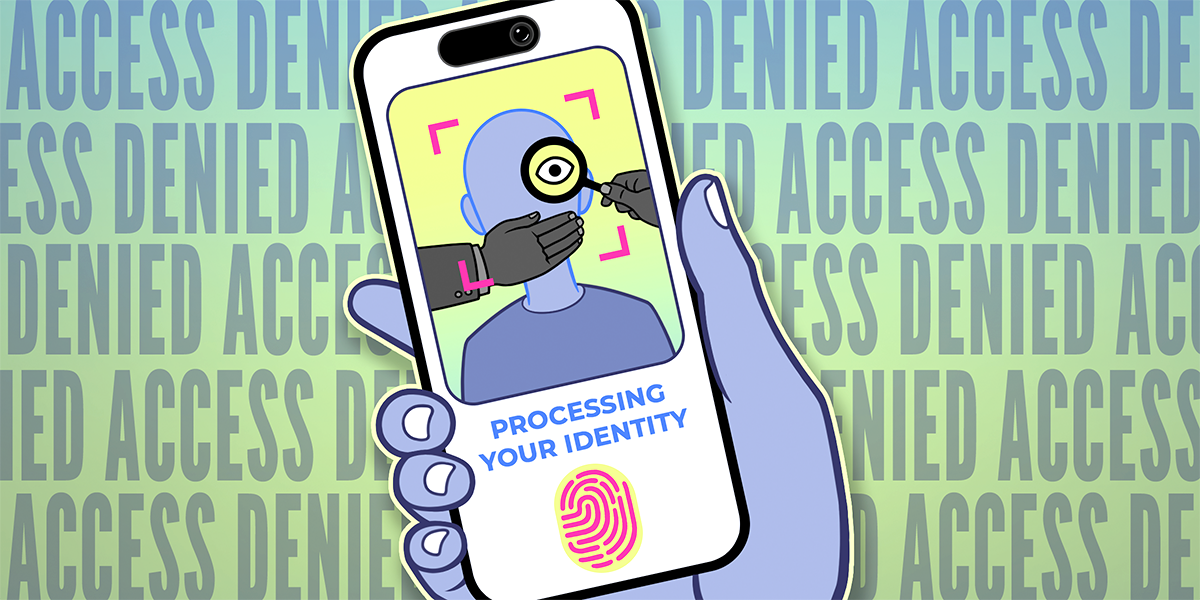In the past few years, governments across the world have rolled out different digital identification options, and now there are efforts encouraging online companies to implement identity and age verification requirements with digital ID in mind. This blog is the third in a short series that explains digital ID and the pending use case of age verification. Here, we cover alternative frameworks on age controls, updates on parental controls, and the importance of digital privacy in an increasingly hostile climate politically. You can read the first two posts here, and here.
Observable harms of age verification legislation in the UK, US, and elsewhere:
As we witness the effects of the Online Safety Act in the UK and over 25 state age verification laws in the U.S, it has become even more apparent that mandatory age verification is more of a detriment than a benefit to the public. Here’s what we’re seeing:
It’s obvious: age verification will not keep children safe online. Rather, it is a large proverbial hammer that nails everyone—adults and young people alike—into restrictive parameters of what the government deems appropriate content. That reality is more obvious and tangible now that we’ve seen age-restrictive regulations roll out in various states and countries. But that doesn’t have to be the future if we turn away from age-gating the web.
Keeping kids safe online (or anywhere IRL, let’s not forget) is a complex social issue that cannot be resolved with technology alone.
The legislators responsible for online age verification bills must confront that they are currently addressing complex social issues with a problematic array of technology. Most of policymakers’ concerns about minors’ engagement with the internet can be sorted into one of three categories:
- Content risks: The negative implications from exposure to online content that might be age-inappropriate, such as violent or sexually explicit content, or content that incites dangerous behavior like self-harm.
- Conduct risks: Behavior by children or teenagers that might be harmful to themselves or others, like cyberbullying, sharing intimate or personal information or problematic overuse of a service.
- Contact risks: The potential harms stemming from contact with people that might pose a risk to minors, including grooming or being forced to exchange sexually explicit material.
Parental controls—which already exist!—can help.
These three categories of possible risks will not be eliminated by mandatory age verification—or any form of techno-solutionism, for that matter. Mandatory age checks will instead block access to vital online communities and resources for those people—including young people—who need them the most. It’s an ineffective and disproportionate tool to holistically address young people’s online safety.
However, these can be partially addressed with better-utilized and better-designed parental controls and family accounts. Existing parental controls are woefully underutilized, according to one survey that collected answers from 1,000 parents. Adoption of parental controls varied widely, from 51% on tablets to 35% on video game consoles. Making parental controls more flexible and accessible, so parents better understand the tools and how to use them, could increase adoption and address content risk more effectively than a broad government censorship mandate.
Recently, Android made its parental controls easier to set up. It rolled out features that directly address content risk by assisting parents who wish to block specific apps and filter out mature content from Google Chrome and Google Search. Apple also updated its parental controls settings this past summer by instituting new ways for parents to manage child accounts and giving app developers access to a Declared Age Range API. Where parents can declare age range and apps can respond to declared ranges established in child accounts, without giving over a birthdate. With this, parents are given some flexibility like age-range information beyond just 13+. A diverse range of tools and flexible settings provide the best options for families and empower parents and guardians to decide and tailor what online safety means for their own children—at any age, maturity level, or type of individual risk.
Privacy laws can also help minors online.
Parental controls are useful in the hands of responsible guardians. But what about children who are neglected or abused by those in charge of them? Age verification laws cannot solve this problem; these laws simply share possible abuse of power with the state. To address social issues, we need more efforts directed at the family and community structures around young people, and initiatives that can mitigate the risk factors of abuse instead of resorting to government control over speech.
While age verification is not the answer, those seeking legislative solutions can instead focus their attention on privacy laws—which are more than capable of assisting minors online, no matter the state of their at-home care. Comprehensive data privacy, which EFF has long advocated for, is perhaps the most obvious way to keep the data of young people safe online. Data brokers gather a vast amount of data and assemble new profiles of information as a young person uses the internet. These data sets also contribute to surveillance and teach minors that it is normal to be tracked as they use the web. Banning behavioral ads would remove a major incentive for companies to collect as much data as they do and be able to sell it to whomever will buy it from them. For example, many age-checking tools use data brokers to establish “age estimation” on emails used to sign up for an online service, further incentivizing a vicious cycle of data collection and retention. Ultimately, privacy-encroaching companies are rewarded for the years of mishandling our data with lucrative government contracts.
These systems create much more risk online and offline for young people in terms of their privacy over time from online surveillance and in authoritarian political climates. Age verification proponents often acknowledge that there are privacy risks, and dismiss the consequences by claiming the trade off will “protect children.” These systems don’t foster safer online practices for young people; they encourage increasingly invasive ways for governments to define who is and isn’t free to roam online. If we don’t re-establish ways to maintain online anonymity today, our children’s internet could become unrecognizable and unusable for not only them, but many adults as well.
Actions you can take today to protect young people online:
- Use existing parental controls to decide for yourself what your kid should and shouldn’t see, who they should engage with, etc.
- Discuss the importance of online privacy and safety with your kids and community.
- Provide spaces and resources for young people to flexibly communicate with their schools, guardians, and community.
- Support comprehensive privacy legislation for all.
- Support legislators’ efforts to regulate the out-of-control data broker industry by banning behavioral ads.
Join EFF in opposing mandatory age verification and age gating laws—help us keep your kids safe and protect the future of the internet, privacy, and anonymity.



